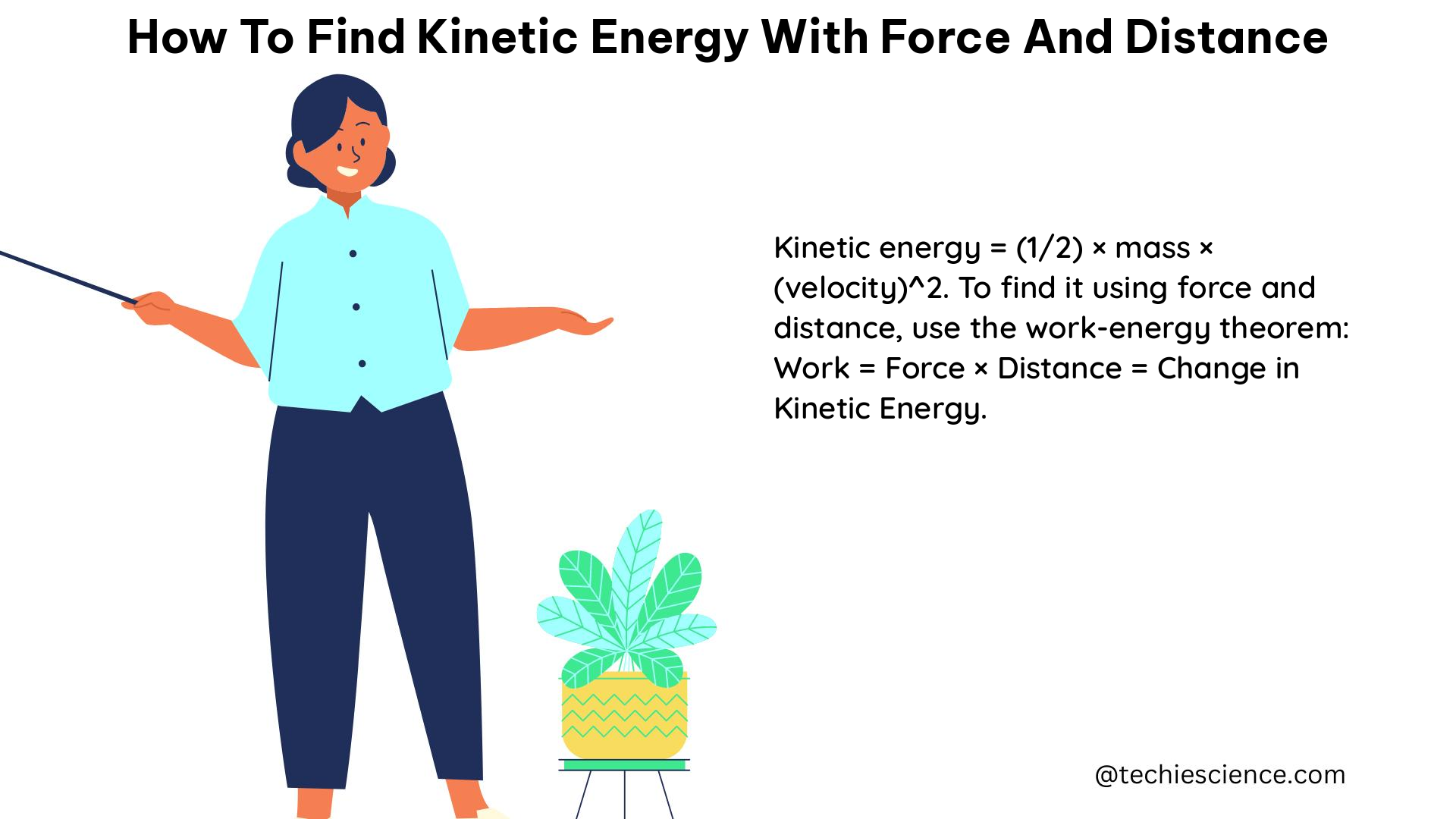To find the kinetic energy of an object using force and distance, we can apply the work-energy theorem, which states that the change in kinetic energy of an object is equal to the work done on the object by an external force. By calculating the work done, we can determine the final kinetic energy of the object.
Understanding the Work-Energy Theorem
The work-energy theorem is a fundamental principle in classical mechanics that relates the work done on an object to the change in its kinetic energy. Mathematically, the work-energy theorem can be expressed as:
W = ΔKE
where W is the work done on the object, and ΔKE is the change in the object’s kinetic energy.
The work done on an object can be calculated as the product of the force applied and the distance traveled:
W = F × d
where F is the force applied, and d is the distance traveled.
Combining these two equations, we can express the change in kinetic energy as:
ΔKE = F × d
This relationship allows us to determine the final kinetic energy of an object if we know the initial kinetic energy, the force applied, and the distance traveled.
Calculating Kinetic Energy

The kinetic energy of an object is a scalar quantity that depends on the object’s mass and velocity. The formula for calculating kinetic energy is:
KE = 1/2 × m × v^2
where KE is the kinetic energy, m is the mass of the object, and v is the velocity of the object.
Let’s consider an example to illustrate the process of finding kinetic energy using force and distance.
Example: Calculating Kinetic Energy of a Car
Suppose we have a car with a mass of 1000 kg moving at an initial speed of 20 m/s. We want to find the final kinetic energy of the car after applying a force of 5000 N over a distance of 50 meters.
-
Calculate the initial kinetic energy:
KE_initial = 1/2 × 1000 kg × (20 m/s)^2 = 400,000 J -
Calculate the work done by the applied force:
W = F × d = 5000 N × 50 m = 250,000 J -
Calculate the final kinetic energy using the work-energy theorem:
KE_final = KE_initial + W = 400,000 J + 250,000 J = 650,000 J
Therefore, the final kinetic energy of the car is 650,000 Joules.
Factors Affecting Kinetic Energy
Several factors can influence the kinetic energy of an object:
-
Mass: The kinetic energy of an object is directly proportional to its mass. Doubling the mass of an object will double its kinetic energy, given the same velocity.
-
Velocity: The kinetic energy of an object is proportional to the square of its velocity. Doubling the velocity of an object will quadruple its kinetic energy.
-
Force and Distance: The work done on an object, which is the change in its kinetic energy, is directly proportional to the force applied and the distance traveled.
-
Direction of Force: The work done on an object is only affected by the component of the force in the direction of motion. If the force is applied in the opposite direction of motion, the work done will be negative, and the kinetic energy will decrease.
Practical Applications of Kinetic Energy
Kinetic energy is a fundamental concept in physics with numerous practical applications, including:
-
Automotive Engineering: Kinetic energy is crucial in the design of vehicle braking systems, where the energy of a moving vehicle must be dissipated safely.
-
Sports and Athletics: Kinetic energy plays a significant role in sports, such as the impact force in collisions, the power of a baseball pitch, or the force of a golf swing.
-
Energy Storage: Kinetic energy can be stored in flywheels or other mechanical systems for energy storage and release, which is useful in applications like hybrid vehicles and renewable energy systems.
-
Particle Accelerators: High-energy particle accelerators, such as those used in nuclear physics research, rely on the principles of kinetic energy to accelerate particles to extremely high velocities.
-
Ballistics and Projectile Motion: Kinetic energy is essential in understanding the behavior of projectiles, such as bullets or missiles, and their impact on targets.
By understanding the relationship between kinetic energy, force, and distance, you can apply these principles to a wide range of physical phenomena and engineering problems.
Conclusion
In summary, to find the kinetic energy of an object using force and distance, you can apply the work-energy theorem, which states that the change in kinetic energy is equal to the work done on the object. By calculating the work done, which is the product of the force applied and the distance traveled, you can determine the final kinetic energy of the object.
This comprehensive guide has provided you with the necessary theoretical background, formulas, and examples to help you understand and apply the concepts of kinetic energy, force, and distance in various physics and engineering applications.
References
- Khan Academy. (2021). Calculating kinetic energy. Retrieved from https://www.khanacademy.org/science/hs-physics/x215e29cb31244fa1:modeling-energy/x215e29cb31244fa1:calculating-energy/v/calculating-kinetic-energy
- Study.com. (n.d.). Practice applying velocity and energy formulas. Retrieved from https://study.com/academy/lesson/practice-applying-velocity-energy-formulas.html
- OpenStax. (2016). University Physics Volume 1. Retrieved from https://openstax.org/books/university-physics-volume-1/pages/10-4-moment-of-inertia-and-rotational-kinetic-energy

The lambdageeks.com Core SME Team is a group of experienced subject matter experts from diverse scientific and technical fields including Physics, Chemistry, Technology,Electronics & Electrical Engineering, Automotive, Mechanical Engineering. Our team collaborates to create high-quality, well-researched articles on a wide range of science and technology topics for the lambdageeks.com website.
All Our Senior SME are having more than 7 Years of experience in the respective fields . They are either Working Industry Professionals or assocaited With different Universities. Refer Our Authors Page to get to know About our Core SMEs.